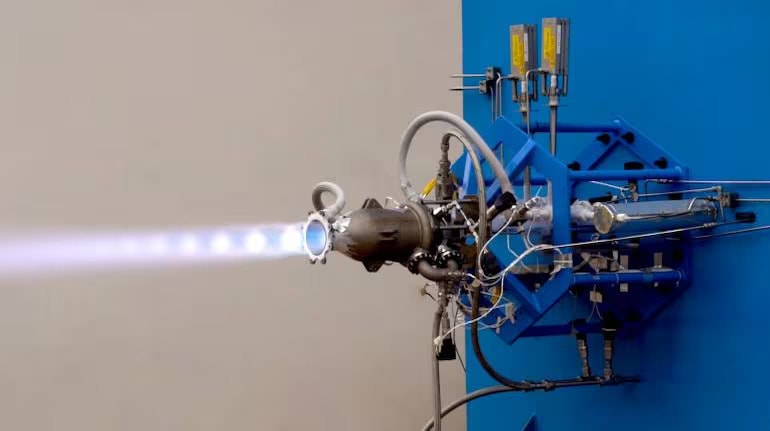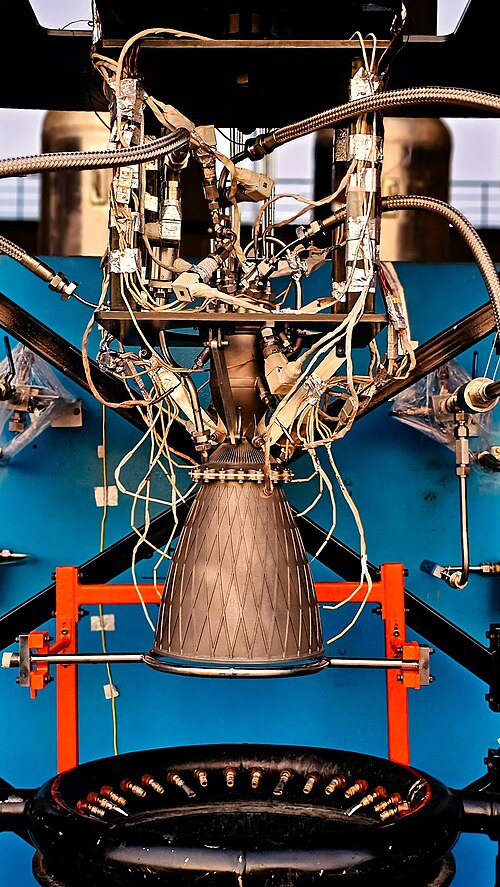In a significant leap for India’s private space sector, Skyroot Aerospace has successfully tested its 3D-printed Raman 2 engine equipped with a vacuum nozzle, marking the final flight-qualified iteration of the engine. The test lasted an impressive 200 seconds, showcasing the engine’s robust performance and the power of rapid additive manufacturing in space propulsion development.
Innovation by Skyroot
While vacuum nozzles are designed for the low-pressure environment of space and typically experience flow separation under Earth conditions, Skyroot’s engineering team devised an innovative solution. By using water injection to mitigate flow separation zones, the team was able to simulate full-area ratio testing on Earth—an otherwise challenging feat.
“This clever workaround allowed us to gather critical performance data right here on the ground,” the company shared. “And it made for some fiery footage too.”
The Raman 2 engine, entirely produced using 3D printing, exemplifies Skyroot’s commitment to rapid Design-Print-Fire development cycles. This approach significantly reduces turnaround time and enables faster innovation in propulsion technology.
With this successful test, Raman 2 is now ready for its role in future space missions, reinforcing Skyroot Aerospace’s position at the forefront of India’s growing commercial spaceflight capabilities.
In 2022 Hyderabad based Skyroot Aerospace, became the first private company from the country to launch a rocket into space, and in 2023 announced that it has successfully test fired Dhawan-II, a 3D-printed cryogenic rocket engine.

The Role of 3D Printing in the Future of Spaceflight
Skyroot Aerospace’s use of additive manufacturing—or 3D printing—reflects a broader shift in how modern aerospace systems are being designed and developed. In the demanding environment of space, 3D printing offers a transformative advantage: lighter, more complex, and faster-to-produce components that traditional manufacturing methods struggle to deliver at the same speed or flexibility.
For Skyroot, 3D printing is more than a manufacturing tool—it’s a foundational part of its design philosophy. From reducing part count and weight to enabling rapid prototyping, the company has embraced additive manufacturing to shorten development cycles dramatically. The Raman engine series, including the latest Raman 2, is a direct result of this mindset, combining high-performance materials with advanced design geometries made possible only through 3D printing.
This approach is not unique to Skyroot. Globally, major players in the aerospace industry are also embracing 3D printing. Companies like SpaceX, Rocket Lab, and Relativity Space have demonstrated how additive manufacturing can disrupt traditional propulsion engineering. For example, Rocket Lab’s Rutherford engine features 3D-printed components, while Relativity Space is taking the concept to the extreme by building almost entire rockets using additive manufacturing, including their Terran 1 and upcoming Terran R launch vehicles.
NASA has also been at the forefront of 3D printing for space, using it to produce engine parts, habitats for lunar missions, and even tools aboard the International Space Station. By enabling on-demand manufacturing in orbit or on planetary surfaces, 3D printing is seen as a key enabler of long-duration missions to the Moon and Mars.
For Indian startups like Skyroot, the adoption of such cutting-edge technologies is not just about innovation—it’s also about competitiveness. As India opens up its space sector to private players, startups are seizing the opportunity to match global standards and even set new benchmarks. Skyroot’s success with Raman 2 places it alongside global leaders who are rewriting the rules of rocket science using digital manufacturing.
As Skyroot prepares for future orbital launches with its Vikram series of launch vehicles, the role of 3D-printed propulsion systems will be pivotal. The efficiency, reliability, and flexibility offered by additive manufacturing are proving indispensable in today’s fast-paced race to space.
Original Source for base article

